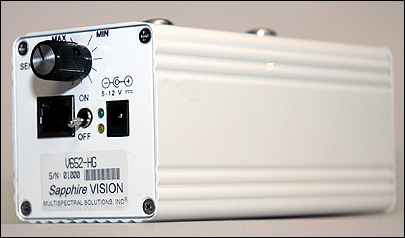Multispectral Solutions Inc. (MSSI), a provider of real-time location systems utilizing ultra wideband (UWB) technology, has introduced an interrogator, the Sapphire Vision, designed specifically for RFID applications. The device works with the same active UWB (6.0 GHz to 6.5 GHz) RFID tags used by the company’s Sapphire Dart real-time location system (RTLS). Vision, however, can only read the 96-bit ID number stored on MSSI’s active UWB tags—it can not determine their locations.
With the Sapphire Dart system, the tags are set to continually transmit short pulses at a rate of one pulse per second. The readers receiving the pulses can be many hundreds of feet away, using a set of algorithms to determine the location of the tags, which use low power and can last an estimated 10 years while running on a simple watch battery. When used with UWB technology, the tags perform well in environments with many sources of RF interference, such as metals or some liquids. Oil giant British Petroleum’s Cherry Point refinery in Washington uses the system to ensure employees can be quickly located in an emergency (see BP Refinery Uses RFID for Evacuation System). Third-party logistics provider GENCO uses it to track forklifts.
“As we deploy more and more Sapphire Dart systems for RTLS applications, we find that our tags have utility far beyond RTLS,” says Robert Fontana, president of MSSI. Because the tags perform well in industrial environments with lots of metal and provide a long read range, he says, they are attractive for active RFID applications. Still, he notes, “to fully address the RFID marketplace, we needed a simpler architecture than Dart, and have developed a stand-alone Sapphire Vision product, the first UWB product explicitly designed for RFID applications.”
The Vision interrogator can read more than 5,000 MSSI tags per second and contains an Ethernet port so it can link directly into a user’s LAN, whereas the Dart reader must first feed the tag data it receives into a processing hub, which contains a computer that determines the location of tags, says Fontana. The Vision reader is also compact, measuring 6 by 3.25 by 2 inches, and weighs 15 ounces. The Vision reader includes a signal attenuator that makes it more or less sensitive to the UWB signals. With this, the user can set the reader to read tags within a limited read range, or all tags within its largest possible read range.
Fontana notes that the Dart system can be configured for strict RTLS operation, a combination of RTLS and RFID, or only RFID. This is done via settings in the processor hub that designate whether the tag data collected by each Dart reader will be utilized for location or just for collecting tag IDs. For example, a customer might install Dart readers for RTLS throughout a facility and set the processing hub to determine the location of tags sensed by these readers. A consumer might also install a reader in a storage room and set the processing hub to collect tag IDs only, without determining each tag’s location. For customers interested only in reading tags, not locating them, purchasing the Dart system would be overkill.
Fontana says the Dart processing hub contains software for visualizing location and for listing the sensed tag, and that the Vision device uses embedded software for producing inventory data the user can call up by keying the interrogator’s Internet protocol number into a browser. He adds that MSSI has partnered with a number of middleware providers, including IBM and Geodan Mobile Solutions. These companies’ middleware can pull data from the interrogators using a TCP/IP connection and link it to other applications, such as sending alerts to personnel if certain tagged items leave the range of a designated interrogator.
The MSSI tags cost $40 apiece, discounted to $15 in large quantities, but this still makes them too expensive to justify their use on low-value goods, says Fontana. The Vision readers are available now and cost $2,600 each. Fontana says MSSI is marketing the product to companies in the health-care and manufacturing industries, for asset or product inventory applications. How many Vision interrogators an end user purchases will depend on the size of the facility and the number of different read zones they want to create. A single Vision reader can detect a tag from as far away as 1,100 feet, says Fontana, but only in free air. For signals traveling through multiple rooms in a large building, the Vision reader might only detect tags from about 150 feet or so. The Dart readers are the same price, but the required processing hub costs roughly $5,000.


